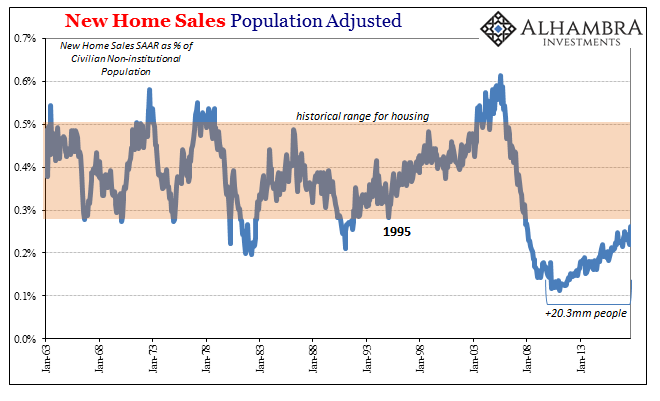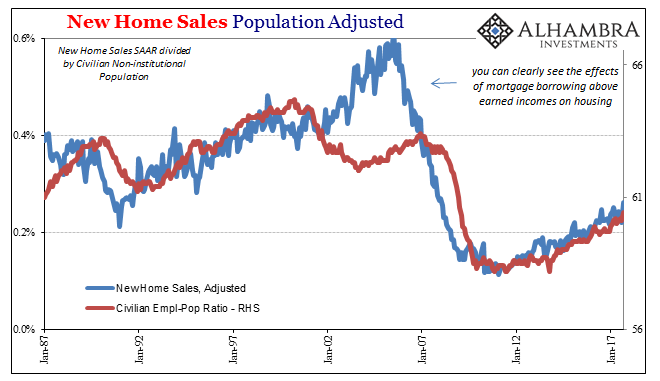New home sales rose almost 20% in September 2017 from August 2017. In just the one month, the pace of sales surged from a seasonally-adjusted annual rate of 561k to 667k. The latter monthly estimate was the highest since 2007, therefore much is being made of that comparison.
As usual, it’s a false one. Given the scale of the housing bust, anything still compared to 2007 isn’t good. In fact, unadjusted there were fewer new homes sold in September 2017 (52k) than there were in September 1995 (54k) despite the worldwide coverage of the one monthly gain. Twenty-two years ago the housing market was more like normal, just getting into the first stages of the housing bubble.
Across that long period of time, however, the official labor force has grown by 28.5 million, a relatively small amount given the labor market inflection in 2008-09. The civilian non-institutional population, the amount of potential labor, has increased by 56.6 million since then. And yet fewer new houses were sold this September in what is being characterized in the most glowing and positive terms than that one when the economy was supposed to have been proportionally smaller.



That demonstrates very well the scale of both the housing bubble and its bust, but more so the economics of the disruption in between, which wasn’t a recession. Almost all analysis fails to account for 2007-09.
So what happened in September? Almost surely some of the increase was storm-related, but not all of it. In statistical terms, for whatever data reason, unadjusted September 2017 sales were above those in August. The seasonal adjustments “expect” the opposite to happen, when in “normal” circumstances sales in any given September remain on the typical late summer downswing.

So it was partially a hurricane-related bounceback that broke the expected seasonal trend – but not all. The rest of the unadjusted increase is a bit of a mystery.
The data for new home sales is derived from other sources like housing permits. Two-thirds of these new homes that were estimated to have been sold in September aren’t built yet, many haven’t even been started. Single-family permits last month weren’t exactly robust, rising just 4.6% unadjusted year-over-year, but, more importantly given the context here, were less in September than in August (as is usual).

For sales to break the seasonal pattern and do so enormously can’t have originated with permits. Again, that seems to be something Harvey and Irma might have contributed, but to what degree is entirely uncertain; as is to what else might have motivated the change (including statistical noise or an anomaly that amplified the weather effects).
In any case, the housing data is being celebrated like today’s durable goods for something it is not, and unlike durable goods for reasons that aren’t really clear. It’s a perfect summation of the 2017 economy.

Stay In Touch